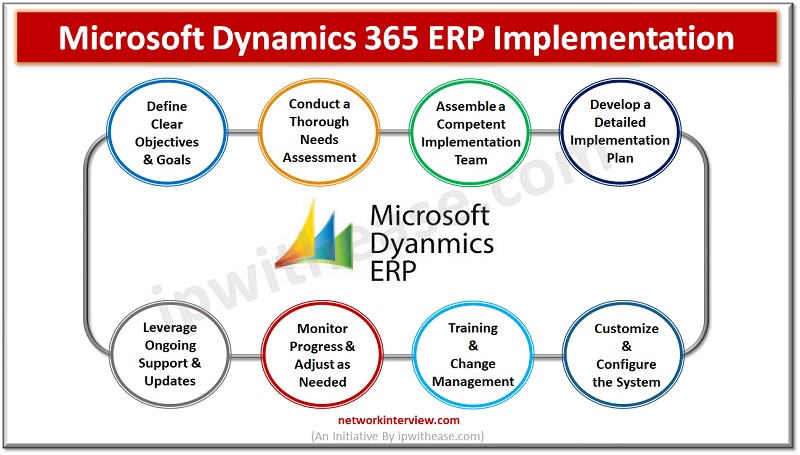
Maximizing ROI Through Strategic Microsoft Dynamics 365 ERP Implementation
Organizations are continually looking for methods to improve efficiency, simplify processes, and boost profitability in today’s dynamic business world. Microsoft Dynamics 365 ERP, an integrated enterprise resource planning system created to improve many parts of corporate management, is one of the primary instruments enabling firms to achieve these goals.
A strategic strategy that takes into account the particular demands and objectives of the business is necessary for the effective installation of a Microsoft ERP system. Today we’ll go into the realm of Microsoft ERP installation and look at how well-planned, strategic implementation processes may help businesses get the most return on their investments (ROI).
Understanding the Role of Microsoft Dynamics 365 ERP
A complete set of cloud-based business software, Microsoft Dynamics 365 ERP includes a wide variety of features, including finance, supply chain management, human resources, and customer relationship management (CRM). Its main goal is to make it possible for enterprises to consolidate data, automate procedures, and get real-time operational insights. As a result, it enables organizations to decide with knowledge, enhance teamwork, and promote growth.
The Importance of ROI in Microsoft ERP Implementation
Any business making the large expenditure to implement a Microsoft ERP system must evaluate the return on that investment. The Microsoft ERP implementation process should be well executed, and the organization’s urgent demands should be met, but it should also offer a long-term strategic benefit that generates measurable ROI. Here are several reasons ROI important while implementing Microsoft ERP:
1. Justification of Investment:
Organizations may justify their choice to invest in Microsoft Dynamics 365 ERP by calculating ROI. It quantifies the advantages and disadvantages of the implementation, guaranteeing that the investment is in line with the strategic goals of the company.
2. Performance Evaluation:
ROI acts as a critical performance measure for the implementation’s success. It enables businesses to evaluate if the system is bringing about the anticipated advantages and whether changes are necessary to enhance ROI.
3. Resource Allocation:
Organizations can better deploy resources when they understand ROI. It gives information on which parts of the implementation need more funding or attention and which ones are doing effectively.
4. Continuous Improvement:
ROI analysis is a continuous process. To guarantee that their Microsoft ERP solution continues to provide value over time, it urges enterprises to regularly assess and enhance it.
Maximizing ROI Through Strategic Microsoft ERP Implementation
Let’s now explore the methods and recommendations that businesses may use to increase the ROI of their adoption of Microsoft ERP:
1. Define Clear Objectives and Goals
Clear objectives and goals are the cornerstone of a successful Microsoft ERP deployment. What do you want to accomplish with the implementation? Is it better financial management, more visibility of the supply chain, or higher sales due to improved CRM? The implementation process will be in line with your strategic vision if your objectives are clearly stated.
2. Conduct a Thorough Needs Assessment
A thorough requirements analysis should be done before you start the implementation. Recognize your organization’s particular needs and trouble spots. Determine the areas where Microsoft Dynamics 365 ERP can have a big effect. The system will be specifically tailored to your needs based on the results of this evaluation.
3. Assemble a Competent Implementation Team
Your implementation team’s abilities and knowledge will determine how well you adopt Microsoft ERP. Make sure your staff has a thorough grasp of the program, your sector, and the procedures of your company. If necessary, take into account hiring outside experts with particular experience in Microsoft ERP setup.
4. Develop a Detailed Implementation Plan
A successful execution requires a well-organized plan. Establish a defined timeframe and milestones for each stage of the implementation process. Think about how each stage fits with your goals and objectives. This plan acts as the project’s overall road map.
5. Customize and Configure the System
Microsoft Dynamics 365 ERP is a very versatile platform that can be customized to meet the specific needs of your business. Utilize this adaptability to configure the system so that it corresponds with your company procedures. Make sure that data transfer and integration with current systems are seamless.
6. Training and Change Management
User adoption is essential for ROI. To guarantee that your workforce is adept at utilizing the new system, invest in training and change management programs. Address any reluctance to change and offer the necessary assistance to ensure a seamless transition for your staff.
7. Monitor Progress and Adjust as Needed
Once the system is operational, keep an eye on its effectiveness and return on investment. To evaluate the effects of the Microsoft ERP deployment, use key performance indicators (KPIs). Be ready to make changes and improvements to optimize ROI if certain areas don’t meet expectations.
8. Leverage Ongoing Support and Updates
Microsoft’s ERP platform is continuously improved and updated. Utilize these upgrades to keep up to date and to make use of new capabilities that might improve your ROI. To solve any problems quickly and guarantee system stability, take into account continuing support and maintenance.
It takes careful planning, effective implementation, and continuing review to maximize ROI through smart Microsoft ERP deployment. Organizations can fully utilize Microsoft Dynamics 365 ERP by defining clear objectives, completing an in-depth requirements assessment, putting together a skilled team, and adhering to best practices all throughout the installation process.
ROI analysis is a crucial tool for evaluating the implementation’s performance and confirming that it is in line with the strategic goals of the company. A properly installed Microsoft ERP system may be a pillar of an organization’s success as it continues to develop and adjust to shifting business environments by offering the agility, effectiveness, and insights required to compete in today’s cutthroat economy.
Continue Reading:
What is an Enterprise Resource Management System?
Business Intelligence vs Data Science



